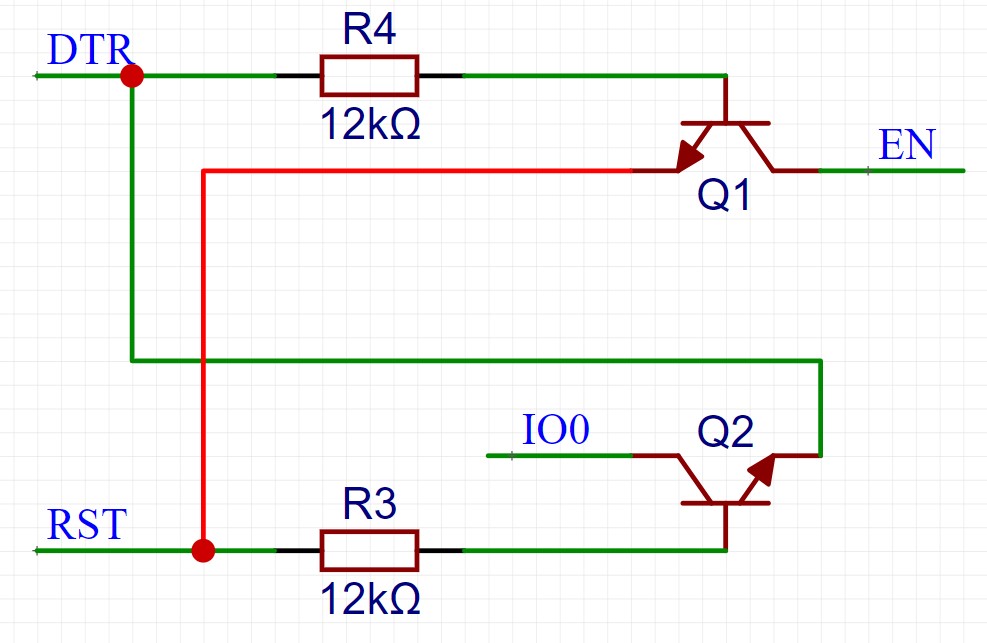ESP32自动下载电路分析
ESP32自动下载电路分析
前言
最近画了块 ESP32 的板子,焊了两块,一块 RESET 有问题,一块 IO0 有问题,导致下载的时候得手动跳线,很是麻烦,于是想搞一下自动下载电路。
硬件原理图分析
自动下载电路图(RST应为RTS)
串口流控机制
- DTR: Data Terminal Ready,数据终端准备好,低有效
- RTS:Request To Send,请求发送,低有效
逻辑关系
- ESP32系统启动模式
| 管脚 | 默认 | SPI Flash 启动模式 | 下载启动模式 |
|---|---|---|---|
| GPIO0 | 上拉 | 1 | 0 |
| GPIO2 | 下拉 | 无关项 | 0 |
| EN | 高有效 | 无关项 | 无关项 |
- 硬件电路逻辑
| DTR | RTS | EN | IO0 |
|---|---|---|---|
| 0 | 0 | 1 | 1 |
| 0 | 1 | 1 | 0 |
| 1 | 0 | 0 | 1 |
| 1 | 1 | 1 | 1 |
总结
当 DTR 和 RTS 同时为 0 或者同时为 1 时,三极管 Q1 和 Q2 均为截止状态,此时 EN 和 IO0 的状态由其他电路决定(内部/外部上拉电阻)。
当 DTR 和 RTS 不同时,EN = RTS, IO0 = DTR。
要进入下载模式,就要保证 EN 由 0 变为 1 时,IO0 得保持低电平。
官方下载源码分析
下面是官方 esptool.py 的下载源码。
1 | def _connect_attempt(self, mode='default_reset', esp32r0_delay=False): |
代码分析
根据注释来看,默认的可能 DTR 直接连接 IO0,RTS 直接连接 EN。但我们这里要根据自动下载电路来分析。因为 python 是解释性语言,语句之间的时间不能忽略。
- DTR = 1, RTS = 0; –> EN = 0, IO0 = 1;
- DTR = 0, RTS = 0; –> EN = 1, IO0 = 1;
- DTR = 0, RTS = 1; –> EN = 1, IO0 = 0;
- DTR = 0, RTS = 1; –> EN = 1, IO0 = 1;
| 管脚 | 时序 |
|---|---|
| EN | ……………./‘’’’’’’’’’’’’’’’’’’’’’’’’’’’’’’’’’’’’’’’’’’’’’’’ |
| IO0 | ‘’’’’’’’’’’’’’’’’’’’’’’’’’’’’’’’\……………./‘’’’’’’’’’’’’’’’ |
要进入下载模式时, EN 复位时 IO0 应该为低电平,至少应该出现下面的时序。当 EN 由 0 变为 1 前后,IO0 至少应该保持一段低电平以保证进入下载模式。
| 管脚 | 时序 |
|---|---|
| EN | ……………./‘’’’’’’’’’’’’’’’’’’’’’’’’’’’’’’’ |
| IO0 | …………………………../‘’’’’’’’’’’’’’’’ |
电路分析
在电路中,EN 一端还连着一个 1uF 的电容。根据数字端口特性, 输入逻辑电平高为 0.75VDD。按照电容充电时间公式可以进行计算
输入逻辑电平高为 0.75VDD。按照电容充电时间公式可以进行计算
$$ 0.75VDD = VDD\cdot (1-e^{-t/RC})$$
将 $VDD = 3.3V$、$R = 12K\Omega$、$C = 1\mu F$ 带入上式计算,可以得到
$$t = 16.6ms$$
即 EN 的上升沿跳变会延迟 16.6 毫秒。在 esptool.py 中,RTS = 1 之后延迟了 50 毫秒,即把 IO0 = 0 的时间延长了 50 毫秒,保证 EN 的电平转换的时间段内 IO0 为低电平,从而进入下载模式。
疑惑
- 在 esptool.py 中,根据注释,貌似乐鑫是直接把 DTR、RTS 与 EN、IO0 连着,那么这样搞自动下载电路可以吗?
最初的电路确实是 DTR、RTS 直接接的 EN、IO0,只是因为有部分串口程序自动打开了硬件 flow control,导致默认 RTS 被拉低,ESP 会一直保持在复位状态;详细信息见 https://www.esp32.com/viewtopic.php?t=5731#p24882 - 在抄安信可的 NODEMCU 板子时,发现他的自动下载电路没有那颗电容,不知道是怎么回事。
参考链接
本博客所有文章除特别声明外,均采用 CC BY-NC-SA 4.0 许可协议。转载请注明来自 Star!







